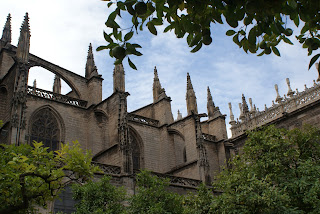 |
| Drying out in Aguadulce boatyard |
 |
| View from the tree tops |
After a long frustrating summer ashore we are now back on the boat and it's a bit of a shock to the system! The boat was out of the water on the hardstanding in a very dusty boatyard in southern Spain. It was also swelteringly hot, in excess of 30°C, but thankfully we missed the blistering summer highs of over 40°C. There was much work to be done before we could splash back in the water. Our arrival back also unknowingly coincided with the Almeria festival which meant our plan to retire to a nice hotel room at the end of each day was scuppered. There was not a room of any description to be found so unfortunately the boatyard was to remain our home. The boat certainly got a good dry out in our absence and we decided to take advantage of this and made the decision to remove all the old bottom paint right down to the original gel coat. After seeing the amount of sanding we would have to do we decided to buy a couple of deckchairs, a bottle of gin and watch the marina staff do the work for us. Time increased and the gin decreased but after rather too many mañanas they eventually got the job done.
 |
| Ride of a Lifetime with her nice white sanded gel coat bottom |
 |
| Manzanilla con hielo y una caña! |
While the sanding progressed at a snail's pace we went about sourcing all the paint and equipment which would be needed to finish the work. Living in a boatyard is not the most comfortable of experiences so we were happy to escape at any opportunity. We also got to know the many local restaurants and tapas bars rather well. Tapas were invented in Andalucia and are more than just snacks. Whenever you order a drink a tapa comes free of charge too. The menus have a wonderful selection of delicacies to choose from and it is
 |
| Tapas - Patatas a la pobre con huevo y Tosta con salmón |
also a great way to try the local specialties. Andalucia is also the home of sherry. This dry, pale white liquid was so good that Sir Francis Drake ransacked the port of Cadiz in 1587 and made off with 3,000 barrels of it! Traditionally tapas were served in bars to accompany a copa de fino (dry Spanish sherry) or draught beer. So, "when in Rome...". We found a great bar overlooking the beach and I chose a Manzanilla sherry - a variety of fino sherry made around Sanlucar de
 |
| Bar with a beach view |
Barrameda in the province of Cadiz. In my best Spanish I asked for a Manzanilla con hielo. To my surprise a cup of Chamomile tea arrived along with a glass of ice! After much hilarity and with the most important word of vino added to the equation my sherry with ice finally arrived. To accompany our sherry and beer we decided to try the patatas a lo pobre (poor man's potato), a delicious concoction of onions, potatoes, peppers and garlic. Apparently there is a bar in nearby Almeria famous for this classic Andalucian dish...one to add to the "to do" list!
 |
| Bar with a marina view |
 |
| Ride of a Lifetime with her grey epoxy bottom |
Meanwhile back in the boatyard we were working at dawn and dusk to avoid the incessant heat. We decided it would be quicker to paint the boat ourselves rather than wait for the marina workers. Three coats of epoxy primer and two coats of antifouling later we were nearly there. Just the grey boot top line to redo as well as the fiddly and rather nerve wracking job of re applying the vinyl boat's name. The old one had suffered from some rather over zealous pressure washing!
 |
| Applying the final coat of black antifouling |
For relaxation and keeping clean we joined the marina yacht club. As well as a washing machine they also have a gym, a roof top swimming pool which very few people seem to use and of course the ubiquitous bar. A brief reprieve from the dusty inferno of the boatyard.
 |
| Admiring the view from the yacht club pool |
 |
| Enjoying a caña and a roof top view |
 |
| The hoist arrives at dawn |
Six weeks later we were finally ready to launch the boat. With our wonderful clean bottom we zipped along to our berth for the winter months. It was now too late to head for pastures new and we still had the Volvo mechanics due to arrive to give our new engine its first year birthday service. The big clean up began, the dust removed and Volvo did their thing. Time now for a much needed holiday!
 |
| Finally on the way back to the water |










































